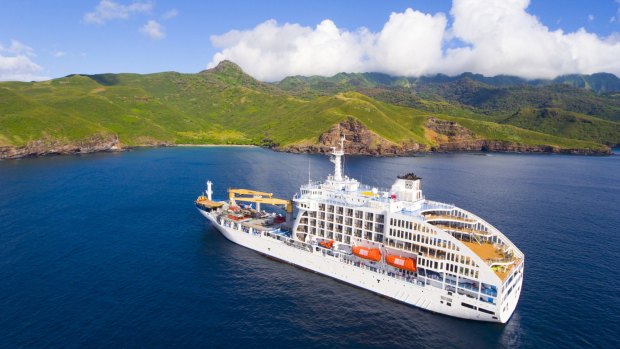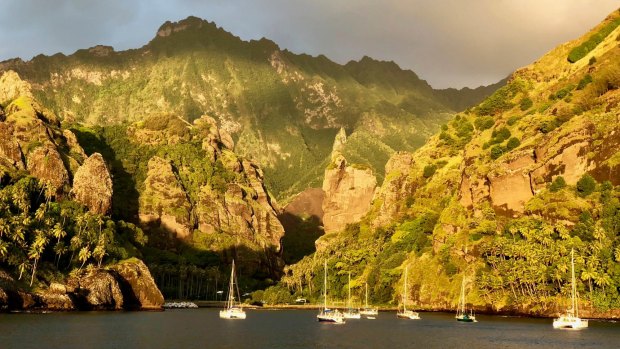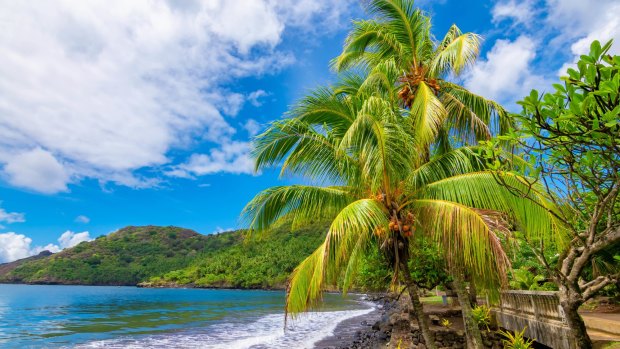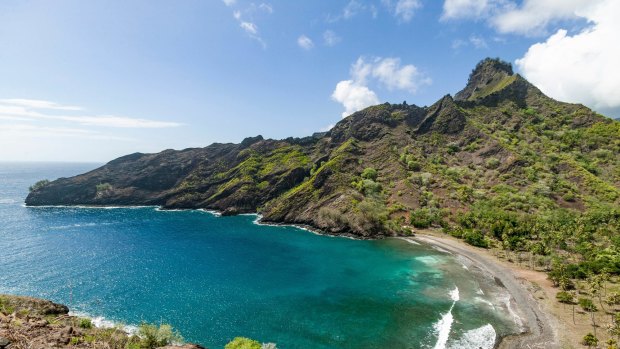This was published 5 years ago
How to get to the Marquesas islands, French Polynesia: Sailing the most isolated archipelago on Earth

Aranui 5 visits the Marquesas Islands every three weeks.
"The whole area was packed with human heads … they lay side by side, grinning in all directions, with big, empty eye sockets, seeming to sniff the jungle air with fleshless nostrils." Thor Heyerdahl, Fatu-Hiva, Back To Nature.
It's the night before I visit the tiny port village of Omoa on Fatu Hiva, where explorer, author and anthropologist Thor Heyerdahl spent a year with his young Norwegian bride. That was 80 years ago; yet as I stand here on the top deck of Aranui 5 – a full moon lighting a path across the bay to the village – I wonder how much has really changed. For the Marquesas are the most isolated island archipelago on earth – they're so removed from the rest of the world that the French government considered testing their atom bombs here in the 1960s (they chose Mururoa Atoll instead, 1300 kilometres south).
There are 12 islands(six are inhabited), 1400 kilometres north-east of Tahiti, inhabited by scarcely 9000 Polynesians. While four islands have makeshift airports with air strips of gravel and dirt, the roads – made mostly of gravel too and which attempt to traverse the almost impassable valleys and mountains of these volcanic isles – make land-based tourism an ordeal. And so the only real way to see the Marquesas is aboard one of the last true cargo ship expeditions available anywhere on Earth. Aranui 5 may be a more luxurious incarnation of the ships that have serviced these islands over the past four decades (Aranui 1 through 3), but passengers still play second fiddle to cargo. Aranui 5 visits the Marquesas every three weeks; on most of the islands, aside from us (and the occasional Pacific-crossing sailor) locals won't see another outsider, making us their only link to the outside world.

The Bay of Virgins.Credit: Shutterstock
Below me – seven decks down – I wonder if Heyerdahl's sharks still patrol these waters. "We knew that the largest blue sharks in the world patrolled the coastal cliffs of the Marquesas Islands," he wrote. "Whenever a wounded goat fell into the sea, triangular shark fins would be seen chasing in from all directions." Even under the cover of darkness – illuminated only by the moon and stars – I can see black-faced volcanic peaks and caldera walls covered in thick jungle. There are none of the famous blue lagoons we associate with Polynesia in the Marquesas; instead visitors hike among the most undulating island landscapes in the Pacific, surrounded by ancient stone walls, altar-like structures, two-metre-high tikis and carvings and petroglyphs – evidence of ancient societies from a time when these islands were the centre of the Polynesian empire.
And when cannibalism reigned supreme. "Entire hillsides covered in jungle hid enormous ruins made of black boulders," iconic travel author Paul Theroux wrote in The Happy Isles Of Oceania. "It was in this respect like Belize or Guatemala – full of huge tumbled structures …" These Marquesas should be the setting for Spielberg's Lost World, not Kauai (in Hawaii) – there's surely dinosaurs somewhere in these mountains – but like the rest of us, Spielberg never realised these islands exist.
After two days of steaming fast across the Pacific from Tahiti, the mountains at our first point of call – on Hiva Oa – seem to climb unfathomably high out of the sea. "The first experience can never be forgotten," Robert Louis Stevenson wrote of his time here in the novel, Casco. "In the morning we awoke in fairyland," is how author Jack London explains his first Marquesas encounter in The Cruise Of The Snark. "The Snark rested in a placid harbour that nestled in an amphitheatre; the towering, vine-clad walls of which seemed to rise directly from the water." Hiva Oa is the best known of all the Marquesas. French artist Paul Gauguin came here to escape the world, and to find inspiration to paint. "I understand why these people [locals] can stay seated for hours or days without saying a word and watch the heavens melancholically," he observed on Hiva Oa. "It seems to me that all the troubled life in Europe no longer exists and that tomorrow will forever be the same and so until the end."

Nuku Hiva, Marquesas Islands.Credit: Shutterstock
Although there's capacity for 250 passengers on board the Aranui 5, it's easy to escape into my own corner of the Marquesas. When the ship docks at our next port village, I linger behind to wander through narrow dirt streets, eating mango, guava and star-fruit, which grow here like weeds. Villages are simple affairs, invariably built around a Catholic Church – no town has more than 500 residents, but most have fewer than 50 – so while I attempt to lose myself, I'm never really lost. Few port towns in these islands have docks large enough to accommodate Aranui 5, and so we anchor in calm bays and are passed from ship-to-tender by crew, and then unloaded again at tiny, concrete jetties. If you're looking for modern sophistication at these ports, you're in the wrong place. When I stumble on my first cafe (on the island of Hiva Oa) I'm handed four mugs – one with instant coffee, another with sugar, one with milk powder and another with hot water. I'm the barista here, it appears.
But we eat like Polynesian kings and queens did – at all-afternoon island feasts, with food prepared in underground ovens, drinking local lager from the bottle, surrounded by mountains and waterfalls and valleys that some of history's most celebrated writers captured in prose. Herman Melville – of Moby Dick fame – jumped ship from a whaling vessel in the 1840s on the island of Nuku Hiva and wrote the novel, Typee, of his time living among cannibals in this valley. "Over all the landscape there reigned the most hushed repose, which I almost feared to break lest, like the enchanted gardens in the fairytale, a single syllable might dissolve the spell," he wrote.
London came here half-a-century later, to live among the paradise Melville described. "The air was like balm, faintly scented with the breath of flowers," London wrote. "One caught one's breath and felt the pang that is almost hurt, so exquisite was the beauty of it." Though it's Heyerdahl's former island home, Fatu Hiva, that's considered the archipelago's most beautiful (which London, Melville or Stevenson never found). I don't find the human bones or villagers in loin cloths on arrival as he did, instead I walk across a mountain pass connecting the island's only two villages.

Hiva Oa, part of the Marquesas Islands.Credit: Shutterstock
"The island we had dreamed of rose from the sea like the morning sun," Heyerdahl wrote. "One valley after the other opened in front of us … only truly vertical precipices had managed to shake off the jungle and rise as naked, red rock above the chaos of luxuriant greenery." I climb higher and higher into these red rocks until my surroundings become mist forest, then I'm rewarded with a nine-kilometre downhill hike into a lush green valley, surrounded by mountains, waterfalls and the emerald waters of Virgin Bay, where Aranui 5 waits at anchor with sunset drinks.
For anyone who thought every adventure on Earth has been taken; that every destination has been conquered, the Marquesas prove otherwise. The isolation of this archipelago will save them from mass tourism; for no airline or hotel chain could ever replace one of the Pacific's last great sea journeys.
TRIP NOTES
FLY
Return airfares with Air Tahiti Nui from Australia to Tahiti (via Auckland) start from $1319, www.airtahitinui.com.au
CRUISE
Aranui 5 offers a regular 13-day voyage from Papeete to nine Tahitian islands across the Marquesas, Tuamotu and Society Islands including Bora Bora, with shore excursions, meals and wine (with on-board meals) included. A Seniors Special departs Australia on June 18, 2019, for 16 nights for $8999 a person, which includes pre- and post-trip accommodation and airfares. Phone 1300 485 846, see ultimatecruising.com.au
MORE
Traveller.com.au/french-polynesia
Craig Tansley travelled courtesy of Aranui 5 and Air Tahiti Nui.
FRENCH POLYNESIA'S OTHER ARCHIPELAGOS
THE GAMBIERS
The least visited of French Polynesia's archipelagos, there are 14 islands located 1600 kilometres south-east of Tahiti dominated by the capital, Mangareva, which can be reached via twice-weekly flights from Papeete.
THE TUAMOTUS
Located north of Tahiti, there are 80 islands and atolls spread across the size of Western Europe (the largest chain of atolls on Earth). However, most are so small there are no airports or safe harbour. Rangiroa is the most popular island, serviced by daily flights from Tahiti.
SOCIETY ISLANDS
The most populated of all French Polynesia's archipelagos – includes the islands of Tahiti, Moorea and Bora Bora. Home to 250,000 locals and located to Tahiti's west, with some separated by just a few kilometres of sea. There are regular flights to almost all islands.
THE AUSTRALS
Located 600 kilometres south of Tahiti, the Australs are made up of seven islands, four accessible by air. There is still an unexplored quality to these islands, and its lagoons are as beautiful as those you'll find in the Society Islands. One of the best places on the planet for whale-watching.
Sign up for the Traveller Deals newsletter
Get exclusive travel deals delivered straight to your inbox. Sign up now.